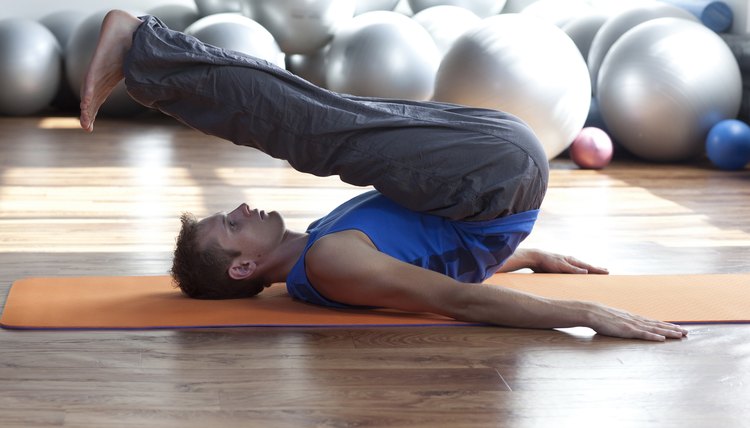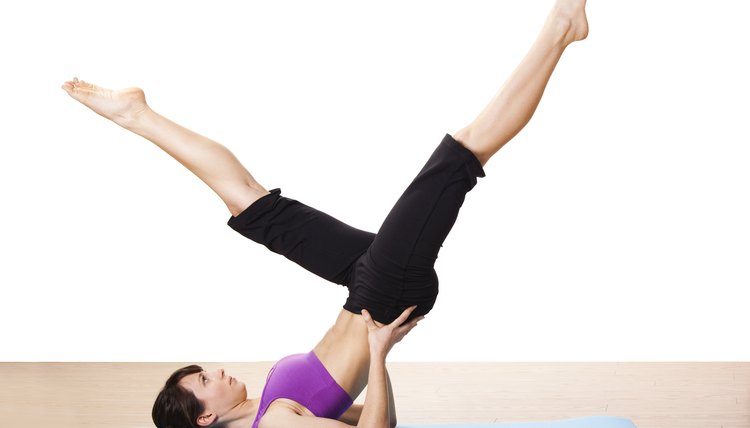How to Reduce Cellulite With Pilates

That stubborn orange peel look that graces thighs, hips and butt cheeks, cellulite is a scourge on 90 percent of women and 10 percent of men. This fat collects just below the skin in pockets that cause dimpling that many find unsightly. You may be overweight or thin, but the odds are, if you're a woman, you have cellulite.
Pilates, with its emphasis on the core muscles of the abs, back, hips and butt, promises to make you a lean, mean Instagram machine. Although Pilates can play a role in weight loss and muscle firming, it won't rid you of cellulite completely. Cellulite is a matter of hormones, genetics and diet — aspects of your life that Pilates can't touch.
However, you can use Pilates as part of a comprehensive cellulite-attacking effort. No treatment can get rid of cellulite completely, but you'll look and feel better as a result of the exercise practice. Commit to a regular practice, along with dietary changes and weight management to minimize cellulite's appearance.
How Pilates Can Help?
Exercising regularly helps reduce the appearance of cellulite. A system such as Pilates helps you burn calories, which contributes to fat loss when you also cut calories. While cellulite can affect you regardless of your weight, it's typically more pronounced if you have extra pounds to lose.
Progress to an intermediate or advanced Pilates practice four times per week for 45 to 60 minutes per session to improve your body composition, suggests the IDEA Health and Fitness Association.

An advanced Pilates practice can meet the requirements for physical fitness.
Improvements in Circulation
Collagen is a protein that keeps you skin springy and taut. When it's lost or becomes slack, the fat cells just under the skin start to protrude through and produce the cottage-cheese look of cellulite. Being sedentary contributes to the depletion of collagen; you've got less circulation to your skin, meaning it receives less nutrients and oxygen to support healthy collagen.
Pilates exercises increase circulation to some of the areas most affected by cellulite. The increase in circulation promotes healthy collagen production and maintenance, which can diminish the appearance of cellulite.
An intermediate or advanced Pilates practice on the reformer or the mat are particularly helpful. Advanced mat moves include exercises such as the bicycle, boomerang, criss-cross and double-leg stretch. What makes the session harder (or advanced) and more effective in burning calories is the pace and complexity of the moves.

An advanced Pilates practice can meet the requirements for physical fitness.
You can't begin at an advanced level, though. Progress your Pilates practice by working with a certified instructor who can help you learn proper form and body positioning. This way, you'll be engaging the muscles correctly and getting the most out of each move when you do advance. Once the body knows how to move, then you can add the more challenging exercises and increase the pace to see the benefits.
Other Strategies
Staying adequately hydrated and eating a diet rich in fruits, vegetables and fiber from whole grains are other important strategies in reducing the appearance of Pilates. Skip the cigarettes, which aggravate the breakdown of collagen that leads to the appearance of cellulite.
Other efforts to maintain a healthy weight are also important in reducing cellulite. In some cases, this might mean calorie restriction, extra exercise and stress management.
References
- Scientific American: Is Cellulite Forever?
- University of Maryland Medical Center: Cellulite
- Dover, J. S., Orringer, J. S., Alam, M. (2014). Body Shaping, Skin Fat and Cellulite E-Book: Procedures in Cosmetic Dermatology Series. United Kingdom: Elsevier Health Sciences.
- Tokarska K, Tokarski S, Woźniacka A, Sysa-Jędrzejowska A, Bogaczewicz J. Cellulite: a cosmetic or systemic issue? Contemporary views on the etiopathogenesis of cellulite. Postepy Dermatol Alergol. 2018;35(5):442-446. doi:10.5114/ada.2018.77235
- Luebberding S, Krueger N, Sadick NS. Cellulite: An evidence-based review. Am J Clin Dermatol. 2015;16(4):243-256. doi:10.1007/s40257-015-0129-5
- American Academy of Dermatology Association. Cellulite treatments: What really works?.
- U.S. Food & Drug Administration. ZELTIQ CoolSculpting System 510(k). Published September 24, 2015.
- Zerini I, Sisti A, Cuomo R, et al. Cellulite treatment: A comprehensive literature review. J Cosmet Dermatol. 2015;14(3):224-40. doi:10.1111/jocd.12154
Writer Bio
Andrea Boldt has been in the fitness industry for more than 20 years. A personal trainer, run coach, group fitness instructor and master yoga teacher, she also holds certifications in holistic and fitness nutrition.
